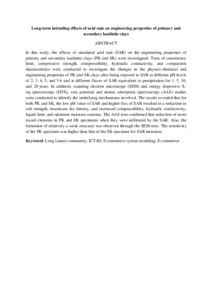Citation
Bakhshipour, Zeinab and Asadi, Afshin and Kim Huat, Bujang and Sridharan, A.
(2016)
Long-term intruding effects of acid rain on engineering properties of primary and secondary kaolinite clays.
International Journal of Geosynthetics and Ground Engineering, 2 (21).
pp. 1-17.
ISSN 2199-9260; ESSN: 2199-9279
Abstract
In this study, the effects of simulated acid rain (SAR) on the engineering properties of primary and secondary kaolinite clays (PK and SK) were investigated. Tests of consistency limit, compressive strength, compressibility, hydraulic conductivity, and compaction characteristics were conducted to investigate the changes in the physico-chemical and engineering properties of PK and SK clays after being exposed to SAR at different pH levels of 2, 3, 4, 5, and 5.6 and at different fluxes of SAR equivalent to precipitation for 1, 5, 10, and 20 years. In addition, scanning electron microscope (SEM) and energy dispersive X-ray spectroscopy (EDX), zeta potential and atomic adsorption spectroscopy (AAS) studies were conducted to identify the underlying mechanisms involved. The results revealed that for both PK and SK, the low pH value of SAR and higher flux of SAR resulted in a reduction in soil strength, maximum dry density, and increased compressibility, hydraulic conductivity, liquid limit, and optimum moisture contents. The AAS tests confirmed that reduction of more traced elements in PK and SK specimens when they were infiltrated by the SAR. Also, the formation of relatively a weak structure was observed through the SEM tests. The sensitivity of the PK specimen was higher than that of the SK specimen for SAR intrusion.
Download File
![[img]](http://psasir.upm.edu.my/54723/1.hassmallThumbnailVersion/Long-term%20intruding%20effects%20of%20acid%20rain%20on%20engineering%20properties%20of%20primary%20and%20secondary%20kaolinite%20clays.pdf)  Preview |
|
Text
Long-term intruding effects of acid rain on engineering properties of primary and secondary kaolinite clays.pdf
Download (111kB)
| Preview
|
|
Additional Metadata
Actions (login required)
 |
View Item |

